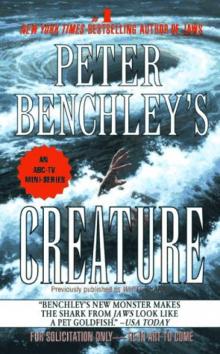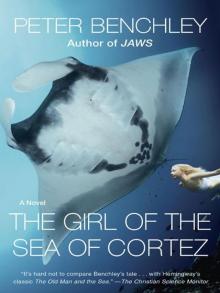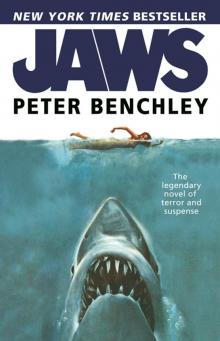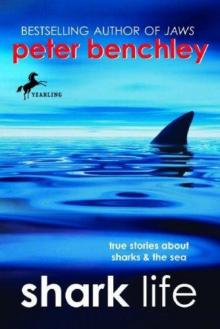- Home
- Peter Benchley
Shark Life: True Stories About Sharks & the Sea Page 12
Shark Life: True Stories About Sharks & the Sea Read online
Page 12
The world grew dark, and for a moment I was afraid. I knew we had gone very deep, but I had no way of knowing exactly how deep because I couldn't let go with one hand to reach for my depth gauge. If we're too deep, I worried, I'll run out of air, or get the bends on surfacing, or—
Just then, as if to reassure me, the manta returned to the world of light. It rushed for the surface, gaining speed with every thrust of its mighty wings. I had the sudden, terrifying conviction that it was going to burst through the surface and take to the air—and me with it. When we slammed down again on the water I would be reduced to pudding. But long before it reached the surface, the manta swerved away and began to cruise twenty or thirty feet below the boat.
Finally, it slowed, then silently stopped directly in the shadow of the boat. I let go and made my way to the surface.
Like Michele, I didn't know how long my journey had lasted, and there was no way to find out. My air tank was almost empty. Stan and Howard had each run through a full load of film, which meant that I had been underwater on that magical ride for at least twenty minutes. But how deep, and for how long, at what depth? The only way I would know how much nitrogen—the villain that brings on bends—was left in my system was to wait. If I came down with the agony of the bends, in my joints or my guts, I'd know I had gone too deep for too long. If I didn't, I'd know I hadn't. Simple as that.
The manta, meanwhile, stayed beneath the boat. Over the next three days, every member of the crew had a chance to swim with or ride on the manta. Always, without exception, the wonderful ray returned its passengers to the same exact spot beneath the boat.
As soon as I returned home, I began to write. A story had been born, entire, in my head. I wrote it at record speed (for me) and with thoughts, feelings, and perceptions I didn't know I had.
It was published as the novel The Girl of the Sea of Cortez. Though it's now out of print, I'm delighted that readers are still discovering it, for it is my favorite of all my books about the sea.
Though the book still clings to life, I'm sorry to report that the magical manta rays of the Sea of Cortez do not. Too many fishermen lost too many nets to the mantas. So they hunted them down until there were none left.
SQUID—GIANT AND OTHERWISE
Of all the creatures that have ever lived in the sea, none has generated more groundless fears and fabulous fantasies than the giant squid. Jules Verne had a giant squid attack the submarine Nautilus in 20,000 Leagues Under the Sea. I wrote a novel about a giant squid, titled Beast, which NBC made into a miniseries. And Richard Ellis, who knows more than I ever will about giant squid, published a fine nonfiction book called The Search for the Giant Squid.
Ellis's title is exactly on target. Almost the entire history of man's relationship with this formidable animal has been a search, and a fruitless one at that. One of the main reasons— if not the main reason—for our endless fascination with this monster of monsters is that so little is known about it. And the reason for that is that despite twenty-first-century technology and the best efforts of battalions of scientists and adventurers, no one has ever seen a giant squid alive in the ocean. What fragments are known have been gathered from studies of specimens either dead or dying in the nets that have trapped them.
Here is a summary of what's known about giant squid. (I've combined facts from Ellis's encyclopedia and my own experiences, conversations, and reading.)
Their scientific name is Architeuthis, which translates from the Greek (roughly) as “first among squid.” Not first in line but first in importance, as in “squid of all squid” or, in today's language, “Man, you de squiiiid.” There are more than a dozen different species of Architeuthis. Most are named for the place their corpses were found. But amateurs like me bundle them all together with the single name Architeuthis dux: king of kings of squid. Sort of.
They are the largest of the more than seven hundred kinds of squid that live in the world's oceans. The biggest one accepted by science was a dead animal found decades ago washed up on a New Zealand shore. It was complete, and was measured at fifty-seven feet long, from its tail to the tip of its two whips, or feeding tentacles. (Unlike octopuses, squid have ten arms, eight short ones plus the two whips.)
The biggest one accepted by me was seventy-three feet long. By the time it washed up on a beach in eastern Canada, some of its arms had been eaten away, so it could not be accurately measured. But scientists studying the remains decided that the animal would have been seventy-three feet long.
I'm even prepared to believe that somewhere in the deep ocean there lives a giant squid more than a hundred feet long. While I was doing research for Beast more than a decade ago, I spoke by phone with one of the world's two great teuthologists (squid scientists). He was ill then and would soon die. Though he was helpful, he insisted that I not attribute anything he said directly to him, for he didn't want to risk his reputation. He told me that his lifetime of study had convinced him that the existence of a 150-foot giant squid was not only possible but probable.
Imagine a squid half the length of a football field … a squid that, standing on end, would reach fifteen stories into the air … a squid longer than three locomotives … a squid … well, you get the idea.
Giant squid seem to inhabit the oceans’ midwater range, between 1,800 and 3,500 feet. That, at least, is where most of the specimens caught recently in fishing nets have been found. There is practically no light at those depths except for what is generated by creatures that are bioluminescent—that is, creatures who give off their own light (like many squid). Giant squid have enormous eyes (the largest in the animal kingdom) that can reach a diameter of fifteen inches. Such huge eyes can gather in every available atom of light.
Throughout history (all the way back to Homer's Odyssey) there have been stories of giant squid attacking and sinking ships. Many of these tales have been supported by witnesses and newspaper accounts, but none has been completely authenticated. Countless stories exist of monster squid assaulting fishermen and plucking unlucky shipwreck survivors from lifeboats. None of those stories would stand up in court, either. But I'm convinced that several, though perhaps wildly exaggerated, spring from seeds of truth. There are simply too many accounts by too many rational people for them all to be fantasies or hallucinations.
Certainly, giant squid are capable of wreaking havoc on small boats and all humans. A giant squid does not have claws within each sucker on its tentacles—claws that are present in many smaller, more aggressive species of squid. But its suckers do have rings of hard, sharp “teeth” made of chitin (the same stuff some mollusk shells are made of). These “teeth” gnaw into prey and drag it toward the animal's big, sharp beak. The beak, in turn, slashes the prey to pieces and feeds it to the squid's studded tongue, which forces the flesh down into the gut.
A lovely way to go, no?
Among the many things not known about giant squid are how big they can grow, how fast they grow, and how long they live. We don't know exactly what they feed on (it is known that sperm whales feed on them). We don't know where they hang out, whether or not they are aggressive, whether or not they are as immensely powerful as legend insists, or why, every year, all over the world, a great many giant squid just seem to die. Because their flesh is loaded with ammonium ions, which are lighter than water, their bodies float rather than sink. Some are eaten by sharks and other fish, but some float all the way to shore more or less intact.
My fascination with giant squid began in the late 1970s, when Teddy Tucker and I decided to try to catch one off Bermuda. Giant-squid bodies—and pieces of bodies—were found floating on the surface there quite often. We went out at night and from the stern of his boat lowered two three-thousand-foot lengths of cable woven of forty-eight strands of stainless steel. Each cable carried clusters of baited hooks of varying sizes, plus Cyalume chemical lights. We hoped the lights would attract the squid's attention.
We had visions of grotesque monsters in the gloomy deep, throbbing with
the colors of excitement (all squid can change color at split-second speeds) as they attacked our baits. We imagined titanic struggles as the cables thrummed with strain and spat droplets of water from each stressed strand. We imagined the stern of the boat being pulled down, down, until—perhaps—Teddy would decide that the only way to save our lives would be to sever the cables with the axe he had stowed nearby.
We waited all night, bouncing around in rough seas, and got no nibbles on either cable. At dawn, filled with disappointment, we began to haul in the cables on giant spools.
They came in easily. Too easily, in fact. Strange.
The five-hundred-foot marker passed, then the thousand-foot. With every turn of the spool the cable seemed lighter, much lighter, weirdly light. The fifteen-hundred-foot marker passed, and now the cables felt too light. Definitely.
Over the stern the cables popped. The lights were gone, the baits were gone, the hooks were gone. The final thousand feet of cable were gone.
The cables had been severed. They hadn't popped from weight or stress; the strands were all still tightly wrapped. They had been cut. Bitten off.
Gloom gave way to excitement. What could have done this? Not a shark. No gigantic fish had swallowed the baited hooks and tried to run with them. We would have felt it; the boat would have moved. And no shark tooth was hard enough to cut through an eighth of an inch of stainless steel.
We couldn't have foul-hooked a whale. Sure, the weight of a whale would have been enough to break the cable. But the cable ends would be splayed, the strands all askew.
Whatever had bitten through our cables, we decided, had a beak as hard as Kevlar, a material used in bulletproof vests, among other things. (How, you ask, could we make that leap of logic? Easy: we wanted to.) And what had such a beak?
Why, nothing—nothing, that is, except a giant squid.
Clearly, this was an animal worth pursuing.
We tried the next year, and the next. We've tried, in fact, every year since then. Always we've been teased; never have we been successful.
We've hung cameras down to two and three thousand feet and focused them on baited hooks. We've seen creatures bizarre and wonderful, including vicious little squid that savaged our bait till nothing was left but scales. We've seen curious, unknown sharks that live only in that particular part of the deep. But we've never seen a sign of Architeuthis.
One day we set a baited line half a mile down and buoyed it with three rubber balls, each designed to float five hundred pounds. We left the line for a couple of hours while we went to set others. When we returned, the balls were gone.
For fifteen or twenty minutes we searched back and forth. There was no question that we were in the right place. Teddy has an uncanny ability to locate himself in the open ocean, especially off Bermuda, where he can pinpoint his position using landmarks.
The balls were gone. Simple as that.
Just as we were about to abandon them—yet another mystery never to be solved—there was a roaring, whooshing sound off the port side of Teddy's boat. One by one— Pow! Pow! Pow!—the three balls burst through the surface, still connected together. They bobbed placidly on the calm sea, as if they'd never been gone at all.
When we pulled in the half mile of line, all the hooks were gone, as were all the baits. Once again, the strands of the rope were still tightly bound. Something had pulled and pulled and pulled, with a force great enough to sink three quarters of a ton, and then bitten through the rope.
In the early 1990s, when I was host of an ESPN series of shows called Expedition Earth, we spent nearly three years putting together an hour on giant squid. We knew that we had next to no chance of being able to film one in the wild. So we filmed some of the animals closely associated with Architeuthis.
We traveled again to Canada, this time to dive—in January, no less, and in falling snow—with the squid's fabulous cousin, the giant octopus. Giant octopuses have been documented to grow as large as sixteen feet in diameter. They are shy, reclusive, and, when they can be coaxed out of their dens, fascinating to watch. As they scurry across the sea floor, they change color and pattern to camouflage themselves to match the bottom they're on or over.
We swam with Caribbean sperm whales in the deep waters around Dominica and Martinique. We were hoping— against all odds—to catch some interaction between whale and squid. The only squid I saw, however, were ex-squid, former squid, squid that were no more. As I snorkeled beside a fifty-foot-long adult sperm whale, it dove down suddenly. As a parting gift it left me enveloped in a thick red cloud of eaten, digested, and excreted giant squid.
We acquired old woodcut prints of beached giant squid and amateur video footage of giant squid killed in fishing nets. Howard Hall shot some extraordinary footage of a hundred-pound Humboldt squid ripping apart a big tuna being hand-fed to it. Humboldt squid are considered to be more dangerous to man than any shark. (One of Howard's other colleagues was later attacked by three Humboldt squid and was lucky to escape with his life.)
In the end we put together a good hour-long show that was, I believe, informative and entertaining. But we never succeeded in finding a single giant squid.
Over the past decade, more and more dead and dying giant squid have been caught by net fishermen, particularly in the waters off New Zealand. The reason is not a sudden population increase in giant squid. The reason is that relatively recent technological advances have given deep-sea trawlers access to fish in water two thousand to five thousand feet deep. There the squid spend a good deal of their time feeding on, among other things, a species of fish called orange roughy.
Orange roughies are amazing fish, only about a foot long, that can live for more than a century. Ellis says that “there are documented records of individuals that have reached 150.” They don't mature until they're about thirty years old. Because they tend to gather in tight schools, they're easy prey for deep trawlers. A five-minute trawl, according to Ellis,
“can fill a trawl net with ten to fifty tons of fish.”
Consequently, orange roughies are being wiped out at an alarming rate. The fishery is only twenty-six years old, and already catches have declined drastically. Some scientists believe that orange roughies may eventually set a record for the speed with which any species (of anything) has gone from initial discovery to commercial extinction.
Meanwhile, though, the presence of giant squid among the orange-roughy populations has lured legions of passionate teuthophiles (squid lovers). Scientists, writers, divers, and filmmakers have gone out on multimillion-dollar expeditions to find giant squid by using submersibles, fifty-thousand-dollar-a-day ships, and the highest of high-tech locating gear.
None has ever seen a giant squid, let alone caught one or filmed a live one swimming in the sea. And, I confess, I'm glad.
Architeuthis is one of the few true mysteries left on earth. It is an animal of mythic stature that we know exists but that we cannot find. It is a real creature that is at the same time an ancient, enduring legend. It is a spur to scientific quest and an inspiration to our imagination.
It is the last dragon. We need our dragons, for they help our fancies soar beyond the boundaries of reality.
I hope the giant squid successfully eludes us for years to come.
14
Even More Creatures to Avoid …
and Respect
Among the immense citizenry of the sea there are many other living things that appear to be inert, passive, and harmless—or alive and friendly. But these creatures can be dangerous if you are inexperienced, careless, or unlucky.
Many corals are poisonous to the touch. They possess stinging cells that are used both for self-defense and to paralyze prey. The most common of the poisonous corals— at least as far as swimmers, snorkelers, and divers are concerned—is fire coral. Fire coral looks like mustard that has been painted onto parts of a reef. Slick, motionless, and harmless-looking, fire coral can deliver a thoroughly nasty sting to an exploring hand.
S
ea anemones are poisonous, too. Their beautiful, waving tentacles seem harmless because colorful little fish swim all around them with no ill effects. In fact, each tentacle can fire toxic harpoons into anything that touches them. The colorful little fish (usually clownfish) are coated with a mucus that makes them immune to the anemone's poison. The relationship is pure symbiosis. The anemone protects the clown-fish from other predators. In return, the clownfish removes food particles and other debris from the anemone, keeping it clean and healthy.
Several species of mantis shrimp can grow to be more than a foot long. These shrimp live in the North Atlantic, the Mediterranean, and the seas around Australia, where they're known as killer prawns. Each has a pair of limbs that fold like the forearms of a praying mantis (hence the name). The limbs unfold like a jackknife, at what seems like the speed of light. The blades are so strong and sharp that they can amputate a human finger with a single stroke. Mantis shrimp are fearless and aggressive. I know several underwater photographers who are seriously afraid of them. When a photographer is concentrating on getting a shot of a tiny creature hiding in a reef, he isn't thinking about what might be burrowed in the sand beside him, ready to pounce and slash his flesh to ribbons.
Spiny sea urchins, black, bristly balls that live on the sea bottom, are harmless—until you happen to step on or bump into one. Then one or more of the hundreds of spines spear you and break off in your flesh. Some species have poisonous spines and some don't, but any urchin spine is amazingly painful. They are difficult to get out (they keep breaking apart into smaller and smaller pieces) and can cause infection.
Some oceangoing critters are obviously dangerous and to be avoided at all costs. Saltwater crocodiles leap quickly to mind. Years ago I worked with a researcher from the National Geographic Society to put together a list of the ten most dangerous animals in the world. We found it impossible not to include saltwater crocodiles.

 Peter Benchley's Creature
Peter Benchley's Creature The Island
The Island Rummies
Rummies The Girl of the Sea of Cortez: A Novel
The Girl of the Sea of Cortez: A Novel Time and a Ticket
Time and a Ticket Jaws
Jaws The Deep
The Deep Q Clearance
Q Clearance Shark Trouble: True Stories and Lessons About the Sea
Shark Trouble: True Stories and Lessons About the Sea White Shark
White Shark Shark Trouble
Shark Trouble Shark Life: True Stories About Sharks & the Sea
Shark Life: True Stories About Sharks & the Sea